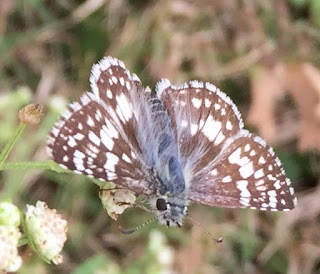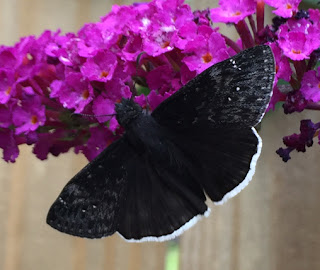What has Dance with Ants, been up to all these long months? Well, a lot of things actually! Working at, The Job, but I always make time for nature.
I've been adding videos to my YouTube channel, Dances with Ants.
If you'd subscribe that would be neat! Feel free to comment!
Tubing Brushy Creek
Dances With Ants - The Adventures of a Suburban Naturalist
Random Nature Goodness.
Blog Archive
Tuesday, July 31, 2018
Sunday, December 18, 2016
It is currently 27 degrees here in Hutto, Texas. Brrr.
What better time to review and share all my inaturalist.org confirmed butterfly sightings over the last year!
All of these pictures were taken in the HuttoParke subdivision in Hutto, Texas. I documented 38 different butterfly species. Rejoice!
All but one species, the Great Purple Hairstreak, was spotted in a suburban yard. I found it at our neighborhood park on some Marsh Elder plants. I don't enhance photos other than to crop the size down and I use my iphone 6 to take the pictures. Enjoy the Butterflies!!
Brazilian Skipper
Add a few Texas native plants along with nectar shrubs and trees then BAM butterflies out the wazoo.
These creatures are able to thrive in human dominated spaces if just given the chance. But that's a blog for another day.
If you're wanting a fantastic resource to expand your nature knowledge and also upload your own pictures of awesomeness, check out http://www.inaturalist.org/, my nickname is marillionjade24.
What better time to review and share all my inaturalist.org confirmed butterfly sightings over the last year!
All of these pictures were taken in the HuttoParke subdivision in Hutto, Texas. I documented 38 different butterfly species. Rejoice!
All but one species, the Great Purple Hairstreak, was spotted in a suburban yard. I found it at our neighborhood park on some Marsh Elder plants. I don't enhance photos other than to crop the size down and I use my iphone 6 to take the pictures. Enjoy the Butterflies!!
American Snout
Brazilian Skipper
Buckeye - my favorite
Ceraunus Blue
Checkered Skipper
Clouded Skipper
Cloudless Sulphur
Common Mestra
Eastern Tiger Swallowtail
Eufala Skipper
Fiery Skipper
Funereal Duskywing
Giant Swallowtail
Gray Hairstreak
Great Purple Hairstreak
Gulf Fritillary
Hackberry Emperor
Horace's Duskywing
Julia
Large Orange Sulphur
Little Yellow
Long-tailed Skipper
Monarch
Ocala Skipper
Orange Barred Sulphur
Painted Lady
Pearl Crescent
Pipevine Swallowtail
Queen
Questionmark
Red Admiral
Sachem Skipper
Southern Dogface
Southern Skipperling
Tailed Orange
Turk's Cap White Skipper
Variegated Fritillary
Viceroy
Wow, right?
These creatures are able to thrive in human dominated spaces if just given the chance. But that's a blog for another day.
If you're wanting a fantastic resource to expand your nature knowledge and also upload your own pictures of awesomeness, check out http://www.inaturalist.org/, my nickname is marillionjade24.
Tuesday, November 1, 2016
So here goes, my first post to my blog.
I've been writing a monthly nature newsletter for my neighbors since January of this year as a Texas Master Naturalist Good Water Chapter individual project. I absolutely love being a part of this volunteer group. My goal with this project is to expose and educate my neighbors to the nature immediately around them that they would most likely pass by. It's literally "Nature, in your backyard". <-- Snazzy right?
I stayed true to my personal goal and only used pictures of butterflies I either took in my suburban postage stamp sized yard or in the neighborhood park. October's issue was all about the "Butterflies of HuttoParke". There were pictures of 22 confirmed species. I've since spotted two new species in my yard. Native Plants people. That post will be for another day. Let all that sink in for a second, 24 species.
With all the stooping, hiding and holding my breath to get unadulterated pics of the butterflies, I wondered, where do they all go at night?
I had a few that were, thankfully, pretty obvious to find. I've only found a few so far, but it's been a neat experience and worth the try if you've never looked before. Dusk and dawn are the best times to look. That's also when the mosquitoes come out, but they live here too. Did you know the male mosquitoes are pollinators? Now of course you can just spray water on your plants and be mean but I wanted to find them in their undisturbed nappy time state.
So where do they go? Take a look at what I found in my own yard:
They don't venture far from their food, which makes a lot of sense considering typical suburban landscape doesn't have much to offer for these little guys. Pretty neat little bit of backyard adventuring there. You could do this
anywhere that has a garden. Chances are you'll find something.
I hope you get out there and find some of these little flappy treasures.
I've been writing a monthly nature newsletter for my neighbors since January of this year as a Texas Master Naturalist Good Water Chapter individual project. I absolutely love being a part of this volunteer group. My goal with this project is to expose and educate my neighbors to the nature immediately around them that they would most likely pass by. It's literally "Nature, in your backyard". <-- Snazzy right?
I stayed true to my personal goal and only used pictures of butterflies I either took in my suburban postage stamp sized yard or in the neighborhood park. October's issue was all about the "Butterflies of HuttoParke". There were pictures of 22 confirmed species. I've since spotted two new species in my yard. Native Plants people. That post will be for another day. Let all that sink in for a second, 24 species.
With all the stooping, hiding and holding my breath to get unadulterated pics of the butterflies, I wondered, where do they all go at night?
I had a few that were, thankfully, pretty obvious to find. I've only found a few so far, but it's been a neat experience and worth the try if you've never looked before. Dusk and dawn are the best times to look. That's also when the mosquitoes come out, but they live here too. Did you know the male mosquitoes are pollinators? Now of course you can just spray water on your plants and be mean but I wanted to find them in their undisturbed nappy time state.
So where do they go? Take a look at what I found in my own yard:
 |
| Two Queen and one Monarch roosting together for the night in an oak tree. Interesting right? |
 |
| A couple of Gulf Fritillary butterflies sleeping on a spent Common Sunflower plant. Can you find them all? 3 at least. |
 |
| Two Queen Butterflies at sunset in a Live Oak tree |
 |
| I see you, Hackberry Emperor butterfly! |
I hope you get out there and find some of these little flappy treasures.
Subscribe to:
Comments (Atom)





































